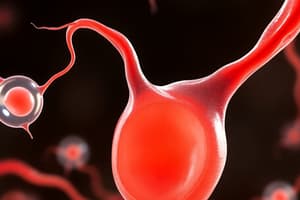Podcast
Questions and Answers
Quale de le sequente assertiones describe le processus de spermatogenesis?
Quale de le sequente assertiones describe le processus de spermatogenesis?
- Le spermatids es producite post le prime division meiotica. (correct)
- Le produzione de gametes masculinos dura circa 30 dies.
- Le spermatogonia se divide in oocytes primaries.
- Le spermas deveni motile in le parte proximal del epididimis.
Que occurre durante oogenesis in le femina?
Que occurre durante oogenesis in le femina?
- Le oocytes arreste in le fase de diplotene durante le meiosis I. (correct)
- Le maximale numero de oocytes occurre in le momento de nativitate.
- Le oogeneis dura 45 dies desde oogenia a ovum.
- Le oocytes primaries se divide imediatemente post le nativitate.
Quot oocytes es tipicamente presente in le femina durante le pubertate?
Quot oocytes es tipicamente presente in le femina durante le pubertate?
- 400,000 (correct)
- 400
- 1 million
- 6-7 million
Quale passo non face parte del processus de fertilisation?
Quale passo non face parte del processus de fertilisation?
Quale de le sequente statementes super le spermas es le plus correct?
Quale de le sequente statementes super le spermas es le plus correct?
What is the primary function of spermatogenesis?
What is the primary function of spermatogenesis?
What is the final product of oogenesis?
What is the final product of oogenesis?
The maximum number of oocytes is reached during puberty.
The maximum number of oocytes is reached during puberty.
Sperms become hypermotile in the __________.
Sperms become hypermotile in the __________.
Match each term with its associated description:
Match each term with its associated description:
Which of the following is NOT a step in fertilization?
Which of the following is NOT a step in fertilization?
Flashcards are hidden until you start studying
Study Notes
Basis Obstetric
- Spermatogenese: Formar gametes masculinos a partir de spermatogonio in 65 dies.
- Processus de spermatogenese:
- Spermatogonio (2n) passa per mitosis.
- Intra meiosi I: Forma spermatocyte secunde (1n).
- Intra meiosi II: Forma spermatid (1n).
- Differentiation porta a spermatozoides.
- Spermatozoides obtine motilitate in le parte distal del epididymis.
- Spermatozoides deveni hypermotile in le cervix.
Oogenese
- Production de ova a partir de oogonia.
- Processus de oogenese:
- Cellula germinative primordial (44XX) forma oogonium (44XX).
- Oogonium developpa in oocita primarie (44XX).
- Primo division meiotic: Oocita secunde (22X).
- Secunde division meiotic: Ovum (oocita maturate) (22X) e polo secunde (22X).
- Maximum de oocitas al 20 septimanas: 6-7 million.
- At nascentia: 1 million oocitas.
- Adolescente: 400,000 oocitas.
- Menopausa: 400 oocitas.
- Arresto in le stadio diplotene de Prophase de meiosi I.
Fertilisation
- Tres passos in fertilisation:
- Penetrar le corona radiata.
- Penetrar le zona pellucida.
- Fusion del ovum e spermatozoide forma le pronucleo.
Basic Obstetrics
Spermatogenesis
- Production of spermatozoa takes approximately 65 days.
- Initiated from spermatogonia (2n) through mitosis and meiosis.
- Meiosis I produces secondary spermatocytes (1n).
- Meiosis II results in spermatids (1n) which differentiate into mature sperm.
Oogenesis
- Involves the production of ova from oogonia.
- Begins with primordial germ cells (44XX) forming oogonia (44XX).
- Primary oocytes (44XX) undergo enlargement and arrest in Prophase I (diplotene stage).
- First meiotic division yields a secondary oocyte (22X) and a first polar body (22X).
- Second meiotic division results in a mature ovum (22X) and a second polar body (22X).
- Maximum oocyte count occurs at 20 weeks of gestation with 6-7 million.
- At birth, approximately 1 million oocytes are present.
- Oocyte count declines to around 400,000 at puberty and to 400 at menopause.
Fertilization
- Occurs in three main steps:
- Penetration of the corona radiata surrounding the ovum.
- Penetration through the zona pellucida.
- Fusion of the ovum and sperm leading to the formation of the pronucleus.
Studying That Suits You
Use AI to generate personalized quizzes and flashcards to suit your learning preferences.




